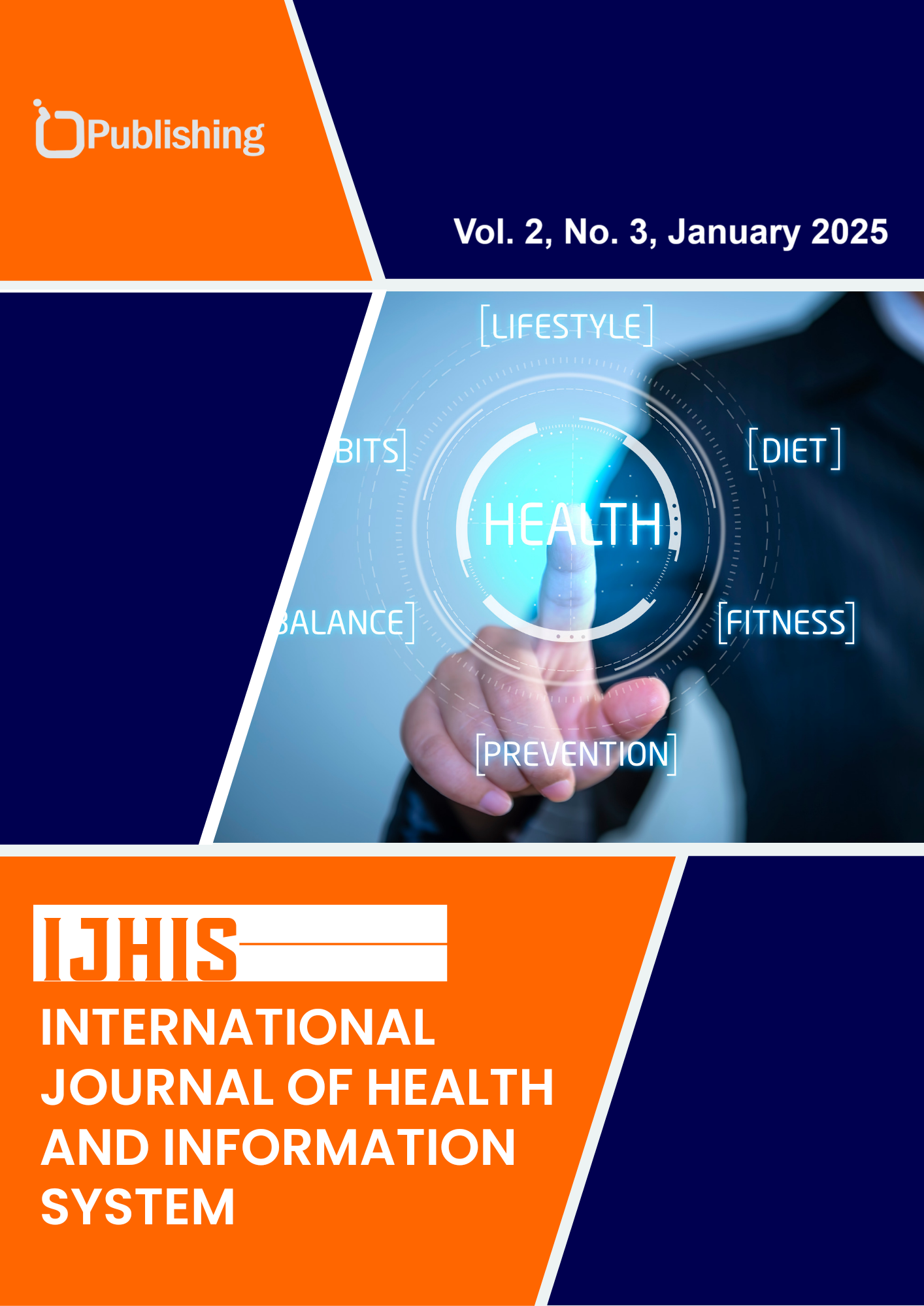Implementation of Risk Factor Detection System Using k-NN Method to Reduce Maternal Mortality Rate at Sumbersari Primary Health Centre
DOI:
https://doi.org/10.47134/ijhis.v2i3.49Keywords:
MMR (Maternal Mortality Rate), Early Detection, Pregnant Women, KNN (K-Nearest Neighbours), SDLCAbstract
The Maternal Mortality Rate has become a major issue for the Indonesian government as it can be used to measure the reproductive health level of a country. In 2023, the maternal mortality rate in Jember Regency was recorded at 150 per 100,000 live births. Sumbersari Primary Heath Centre is one of Primary Health in Jember, located in the city. Still had cases of maternal mortality, with two recorded cases The Jember Regency government has implemented various interventions, including the implementation of integrated antenatal care (ANC), the preparation of emergency obstetric and neonatal management guidelines, and collaboration with educational institutions to support pregnant women, strengthen maternal and neonatal referrals, and enhance the PONED and PONEK maternity teams. In line with these programs, there is a need for synergy in utilizing information technology to support the Jember government’s efforts to reduce maternal mortality rates through the creation of an early detection system to predict maternal deaths. This research will develop an early detection system for maternal mortality using the KNN method. The attributes used include gestational age, weight, haemoglobin, blood pressure A, blood pressure B, facial swelling, stillbirth, breech birth, bleeding during pregnancy, hydramnios, post-term pregnancy, transverse presentation, preeclampsia/eclampsia, anaemia, tuberculosis, malaria, and heart failure. The system development will utilize the prototype method. The test results show that the system can be used to predict maternal mortality with an accuracy
References
[1] D. K. K. Jember, Profil Kesehatan Kabupaten Jember Tahun 2023. 2023.
[2] A. Chatterjee, A. Prinz, M. Gerdes, and S. Martinez, “Digital Interventions on Healthy Lifestyle Management: Systematic Review,” J. Med. Internet Res., vol. 23, no. 11, p. e26931, Nov. 2021, doi: 10.2196/26931.
[3] N. B. Mahiddin, Z. A. Othman, A. A. Bakar, and N. A. A. Rahim, “An Interrelated Decision-Making Model for an Intelligent Decision Support System in Healthcare,” IEEE Access, vol. 10, pp. 31660–31676, 2022, doi: 10.1109/ACCESS.2022.3160725.
[4] K. Hannola, S. Hoppu, S. Mennander, H. Huhtala, H. Laivuori, and K. Tihtonen, “Obstetric early warning system to predict maternal morbidity of pre-eclampsia, postpartum hemorrhage and infection after birth in high-risk women: a prospective cohort study,” Midwifery, vol. 99, p. 103015, 2021, doi: https://doi.org/10.1016/j.midw.2021.103015.
[5] P. Chhabra and R. Madaan, “Data mining concepts in healthcare with discussion on prediction of diseases,” in 2022 International Conference on Machine Learning, Big Data, Cloud and Parallel Computing (COM-IT-CON), May 2022, pp. 71–77. doi: 10.1109/COM-IT-CON54601.2022.9850851.
[6] M. Fatmawati et al., “Maternal Health Risk Classification - A Comparison between Algorithm Decision Tree and k-Nearest Neighbor (kNN),” in 2023 International Conference on Sustainable Emerging Innovations in Engineering and Technology (ICSEIET), Sep. 2023, pp. 507–511. doi: 10.1109/ICSEIET58677.2023.10303507.
[7] A. E. L. Takaeb, “Exploration of Socio-Cultural Determinants of Maternal Mortality in Indonesia,” 2020. doi: 10.2991/aebmr.k.201212.067.
[8] N. Herlina, S. Nawangsari, R. K. Harahap, E. Ekowati, and A. I. Asmarany, “Pengembangan Skrining Deteksi Resiko Kehamilan Berdasarkan Kriteria Keadaan dan Kondisi Ibu Hamil,” J. Aisyah J. Ilmu Kesehat., vol. 6, no. 3, Sep. 2021, doi: 10.30604/jika.v6i3.536.
[9] S. Uddin, I. Haque, H. Lu, M. A. Moni, and E. Gide, “Comparative performance analysis of K-nearest neighbour (KNN) algorithm and its different variants for disease prediction,” Sci. Rep., vol. 12, no. 1, p. 6256, Apr. 2022, doi: 10.1038/s41598-022-10358-x.
[10] K. Gouda, M. Hassaan, and M. J. Zaki, “Prism: A Primal-Encoding Approach for Frequent Sequence Mining,” in Seventh IEEE International Conference on Data Mining (ICDM 2007), Oct. 2007, pp. 487–492. doi: 10.1109/ICDM.2007.33.
[11] R. S. Ghumatkar and A. Date, “Software Development Life Cycle (SDLC),” Int. J. Res. Appl. Sci. Eng. Technol., vol. 11, no. 11, pp. 1162–1165, Nov. 2023, doi: 10.22214/ijraset.2023.56554.
[12] R. S. Weinberg, “Prototyping and the Systems Development Life Cycle,” J. Inf. Syst. Manag., vol. 8, no. 2, pp. 47–53, Jan. 1991, doi: 10.1080/07399019108964983.
[13] R. Domínguez-Domínguez, G. H. Alférez, V. González-Mejia, and N. Donías, “Data Science Application for Creation of Maternal Morbidity and Mortality Predictive Software,” Sep. 2023, pp. 1–8. doi: 10.54808/WMSCI2023.01.1.
Downloads
Published
How to Cite
Issue
Section
License
Copyright (c) 2024 Bakhtiyar Hadi Prakoso, Muhammad Yunus, Angga Rahagiyanto, Veronika Vestine, Gandu Eko Julianto Suyoso, Atma Deharja

This work is licensed under a Creative Commons Attribution-ShareAlike 4.0 International License.







